In this type of remedial cementing job procedure (Cementing in drilling), we are forcing the slurry through openings in the casing or casing liner (One of Types Of Casing). In this article, we will discuss in detail the remedial squeeze cementing job techniques as hesitation, bradenhead squeeze, design & cement retainer procedure. We will also provide an excel sheet for its calculations.
Squeeze Cementing Objective
The objectives of casing cement squeezing are as following:
- To repair a primary casing cementing Operations job by circulation / squeezing cement through csg perforations made specifically for this purpose, separated by a retrievable packer (check also: Permanent Packers). In a leaking liner lap, we usually squeeze cement from the top when injectivity can be established.
- Also, Oil companies are using remedial squeeze cementing jobs to shut off perforations in a depleted interval. In other words, by filling the perforation tunnel and surrounding formation with cement you should be able to shut off perforations.
- In addition to that, we can reduce unwanted gas or water influx by selectively squeezing cementing off perforations.
- When there are casing leaks, a remedial squeeze cementing job into the apertures will repair casing leaks, holes & splits.
A primary cement job repair aims at placing cement outside the casing (check our casing design guide), whereas the other types of cement squeezes are applied primarily to stop undesired communication and influx from outside to inside the casing.
As the success rate of squeeze is fairly low, we should consider this technique as a last resort.
Squeeze Cementing slurry Consideration
The slurry in a squeeze cementing operation should form an initial seal by depositing an internal mud cake on the formation through shallow invasion at pressures below the fracturing gradient. This requires formulating the well cement properties for a low fluid loss and with a particle size distribution in the same order of magnitude as formation pore sizes. It also requires the establishment of whether the formation will take filtrate by carrying out an injectivity test before attempting to squeeze cement.
Squeeze Cementing Techniques
On the drilling rig, you can carry out cement squeezes through the open-ended drill pipe, referred to as ‘poor boy’ or ‘bradenhead’ squeezes, or by using a retrievable or permanent packer.
Also, we can apply circulation squeezes in primary cementation repairs where you are able to establish communication/circulation between the two sets of perforations, separated by a (retrievable) packer
There are two traditional and fundamentally different squeeze job classifications.
- Low-pressure squeeze: The bottom hole treating pressure is maintained below the formation fracturing pressure.
- High-pressure squeeze: The bottom hole treating pressure exceeds the formation fracturing pressure.
Within these two classes, there are:
- Two basic techniques (the Bradenhead squeeze and the squeeze tool technique)
- Two pumping methods (the running squeeze and the hesitation squeeze). Each of these classifications and techniques is explained below.
Low-Pressure squeeze:
Low pressure squeezes where the pressure remains below the fracturing gradient. You can carry out LP squeezes in hesitation or running mode.
In the former technique, you are squeezing the cement in the perforations in small volumes, allowing the pressure to bleed off to the formation between injections. For sure,the injection pressure increases with each successive pumping/bleed-off cycle, on account of the seal being formed. Squeezing continues until the maximum allowable pressure is reached.
High Pressure squeezes
High pressure squeezes at pressures deliberately higher than the fracture gradient to force cement slurry deeper into the formation. It is the method of last resort where you are unable to establish injectivity due to mud contamination or virtually impermeable or tight formations.
Bradenhead squeeze
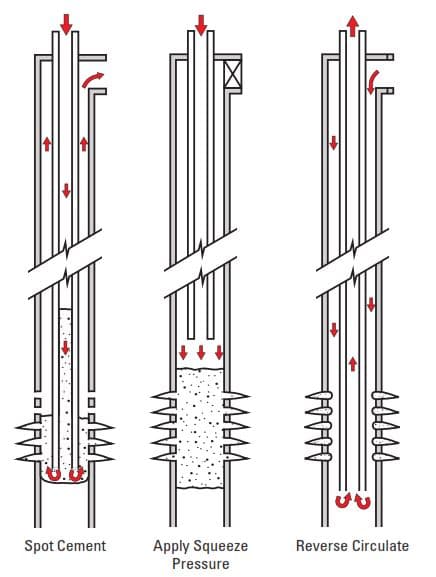
The Bradenhead cement squeeze job procedure, illustrated in Fig.1, is a low-pressure squeeze technique that we can practice when there are no doubts concerning the casing’s ability to withstand the squeeze pressure. No special tools are involved, although a bridge plug may be required to isolate other open perforations farther downhole. its procedure is as follows:
- Run open-ended tubing to the bottom of the interest zone.
- Close blowout preventer (BOP rams) over the tubing
- Perform an injection test.
- Spot the cement slurry in front of the perforations.
- Once the cement is in place, pull the tubing out to a point above the cement top, then close the BOPs, after that apply pressure through the tubing.
The Bradenhead squeeze is popular because of its simplicity.
Retrievable squeeze packer method
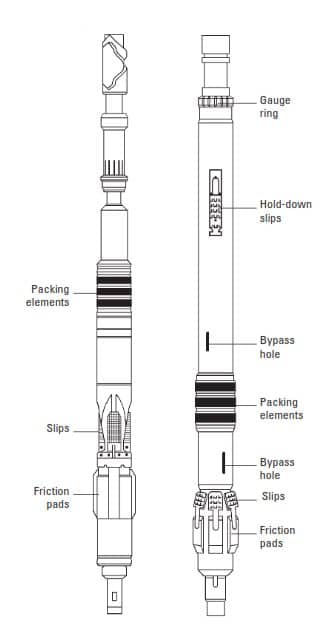
The other methods which can be compared with bradenhead squeeze methods are retrievable packers & drillable cement retainer squeeze.
Retrievable wells packers with different design features are available. We can utilize both Compression- or tension-set packers remedial squeeze cementing job procedures. As shown in Fig.2, they have a bypass valve to allow the circulation of fluids while running in the hole and after the packer is set. This feature allows tool cleaning after the cement job and reversing out excess slurry without excessive pressure. The bypass valve also prevents a piston or swabbing effect while running in or out of the hole.
The principal advantage of the retrievable packer over the drillable cement retainer squeeze is its ability to set and release many times, allowing more flexibility.
Drillable Cement Retainer Squeeze
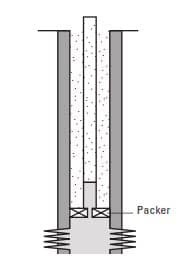
Cement squeeze retainers are drillable packers that have a valve that is operated by a cement stinger at the end of the workstring. We are using cement retainer squeeze procedure to prevent backflow when we are not expecting cement dehydration or when a high negative differential pressure may disturb the cement cake. In certain situations, using a packer is risky because of potential communication with upper perforations. When cementing multiple zones, the squeeze cement retainer isolates the lower perforations. And then we can perform subsequent zone squeezing without waiting for the slurry to set.
In cement retainer squeeze procedure, a drillable retainer gives the operator more confidence in setting the packer closer to the perforations. Another advantage over both bradenhead & retrievable squeeze is that a smaller volume of fluid below the packer is displaced through the perforations ahead of the cement slurry.
Running Squeeze Method Procedure
During a running remedial squeeze procedure, the cement slurry is pumped continuously until the final desired squeeze pressure—which may be above or below the fracture pressure—is attained. Also we are monitoring the pressure after pumping stops. If the pressure falls owing to additional filtration at the cement/formation interface, keep pumping more slurry to maintain the final squeeze pressure.
This continues until the well maintains the squeeze pressure for several minutes without additional cement-slurry injection. The volume of slurry injected is usually large. Rike and Rike (1981) reported that volumes ranging from 10 to 100 bbl are commonly used. A modified running squeeze technique, using pumps that can deliver several barrels of slurry at rates as low as 0.06 bbl/min [10 L/min] to avoid formation fracturing, has been used successfully to seal narrow microannular gaps (Slater et al., 2001).
Hesitation Squeeze Method Procedure
During a remedial squeeze cementing job procedure, the rate at which cement filtrate leaks into the formation is lower than the minimum pump rate of most field equipment. Therefore, maintaining a constant differential pressure is nearly impossible, especially when one is trying not to exceed the formation fracture pressure.
A solution to this problem is the hesitation squeeze pumping method procedure. This hesitation squeeze procedure involves the intermittent application of pressure—by pumping at a rate of 1/4 to 1/2 bbl/min—separated by an interval of 10 to 20 min for pressure falloff caused by filtrate loss to the formation. The initial leakoff is normally fast because there is no filter cake. As the cake builds up and the applied pressure increases, the filtration periods become longer and the differences between the initial and final pressures become smaller. At the end of the job, the pressure falloff becomes negligible (Fig.4). The slurry volumes necessary for this technique are usually much less than those required for a running squeeze.
A loose formation normally requires a long hesitation period to begin building squeeze pressure. A first hesitation period of 30 min or more is not unreasonable. A much shorter initial hesitation period (possibly 5 min) while squeeze cement procedure is normally sufficient for tight formations (Grant and White, 1987). Instead of prescribing pump times, the best method is to continue pumping as long as squeeze pressure continues to build.
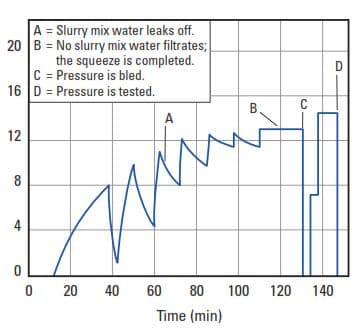
Basic Cement squeeze job procedures
The general procedure ( whatever the method are cement bradenhead, hesitation or retainer squeeze) of events during a remedial cement squeeze job is as below.
Preparation
- Isolate the zones below the interest interval with a retrievable or drillable bridge plug.
- Wash the perforations with a perforation washing tool or are reopen it with the back surging technique.
- Retrieve the perforation washing tool
- If you are going with the packer method, run in the hole with the work string, set at the certain depth, test same. A test pressure of 1,000 psi [6.9 MPa] is usually sufficient.
- If the cement is to be spotted in front of the perforations, a tailpipe covering the length of the zone plus 10 or 15 ft [3 or 5 m] is run below the packer.
- Perform an injection test using clean, solids-free water or brine. This test gives information concerning the permeability of the formation to the filtrate.
If a low-fluid-loss completion fluid is in the hole, displace it from the perforations before starting the injection test.
Circulating
- Circulate down the spearhead fluid followed by the cement slurry downhole with the packer bypass open.
The target of circulation to avoid squeezing damaging fluids ahead of the slurry into the formation. Also there must be a small amount of backpressure on the annulus to prevent slurry free fall as a result of the U-tube effect.
- If there are no tailpipe, close the packer bypass 2 to 3 bbl before the slurry reaches the packer.
- If you are going to spot cement in front of the perforations with the packer unset, stop circulation as soon as the cement covers the selected zone. Then, pull the tailpipe out of the cement slurry, and set the packer at the desired depth.
Carefully select the setting depth of the packer. If you are running a tailpipe, the minimum distance between the perforations and the packer is limited to the length of the tailpipe. Setting the packer must not be too close to the perforations, because pressure communication through the annulus above the packer may cause casing collapse.
Selecting a safe setting depth is important after evaluation of the quality of the cement bond (CBL Log – VDL log – CET) with the logs (Fig. 5). Possible cement slurry contamination by the fluid in the hole limits the maximum spacing between packer and treated zone. In Fig.6, setting the packer too high will allow cement slurry contamination as it channels through mud to reach the perforations.
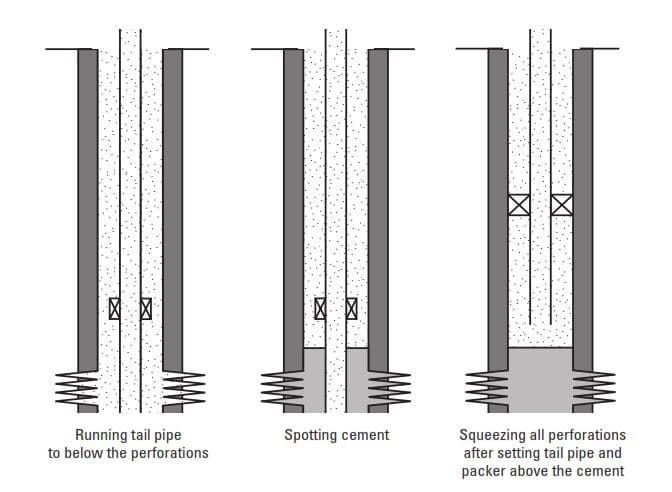
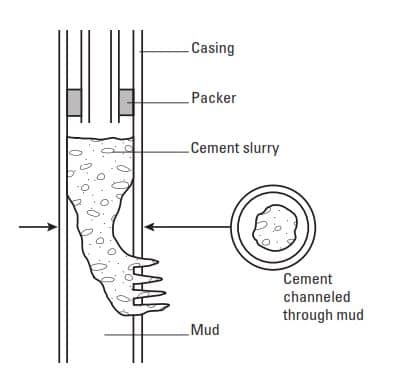
1968; reprinted with permission of SPE)
Shryock and Slagle (1968) recommended that the retrievable packer be set no more than 25 ft [8 m] above the perforations.
Squeezing
- Apply squeeze pressure.
If the high-pressure squeeze technique is used, the formation is broken down, and the cement slurry is pumped into the fracture. For low-pressure squeeze jobs, hesitation pumping begins as soon as the packer is set.
- Pumping continues until no pressure leakoff occurs.
A further pressure test of about 500 psi [3.5 MPa] more than the final injection pressure indicates the end of the injection process. Usually, a well-cemented perforation accepts a pressure above the formation fracturing pressure, but fracturing may occur if one attempts to verify such a condition.
Best Practice Cement retainer Squeezing Cementing Procedures
We can say that there are 3 stages for the remedial squeeze cementing which are:
- Running
- Pumping
- Squeezing & Reverse circulating
Cement Retainer Squeeze Procedure | Running
- Set a Cement Retainer (CR using wireline whenever possible to 5 to 10m above the perforations. Correlate the CCL and GR to avoid setting the CR across a collar or perforations.
- Run the Setting Tool on drill pipe, apply 10 ton weight (ot as per program) on the CR and try to circulate testing the CR and the rubber seals (‘O’ rings by pressurizing up on the annulus.
- Pick-up the stinger and test the surface lines from cementing unit to cementing head at 5,000 psi or as per program.
Cement Retainer Squeeze Procedure | Pumping
- Displace the pipe with 2m3 of water cushion or as per program.
- Stab the stinger in and perform a feeding test, recording injection rates and relevant pressures. Do not exceed fracture pressure.
- Pick-up the stinger and mix and pump the slurry. The slurry design (Check also Cementing Design Guidelines) depends on the feeding test results. In front and after the slurry, pump a cushion of treated water or spacer.
- Displace the first water cushion until it reaches the end of the pipe, then stop pumping and rapidly stab the stinger in. With high density slurries, close the annular BOP with a low pressure before stabbing the stinger in.
- Monitor that a DP tool joint is not across the BOP annular rubber.
Cement Retainer Squeeze Procedure | Squeezing & Reverse circulating
- Apply a moderate squeeze pressure taking into consideration the increased hydrostatic effect of the cement column.
- Gradually increase downhole pressure to 500-1,000psi above the pressure required to initiate the flow calculated with a residual cement column.
- If the pressure reaches a high value, help the stinger seals by applying pressure on the annulus.
- You should consider casing collapse resistance.
- If pressure increases by pumping, proceed until reaching the maximum pressure of 500 psi below fracture pressure. If there are no pressure increase, adopt the ‘Hesitation Technique’. Hesitation technique is pumping small amounts of slurry (just enough to determine if the formation is feeding) and waiting a few minutes allowing for complete bleed-off. Record a residual pressure. Increase the pump pressure according to the increase in bleed off pressure, until the maximum squeezing pressure is reached.
- Pick-up the stinger and reverse circulate out the excess cement. Record the volume fluid taken back.